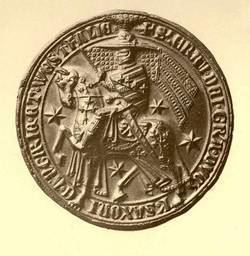Joint Reign 1282–1296 Died 1360, Nienburg, Germany Spouse Elisabeth of Pomerania | Joint Reign 1296–1303 Parents John I, Duke of Saxony Name Eric Duke | |
 | ||
Children Eric II, Duke of Saxe-Lauenburg Grandchildren Eric IV, Duke of Saxe-Lauenburg | ||
Grandparents Albert I, Duke of Saxony | ||
Eric I of Saxe-Lauenburg (c.1280–1360) was a son of John I, Duke of Saxony, and Ingeborg Birgersdotter of Småland (*ca. 1253–30 June 1302*, Mölln), a daughter or grandchild of Birger jarl. He ruled Saxony jointly with his uncle Albert II and his brothers Albert III and John II, first fostered by Albert II, until coming of age. In 1296 Eric, his brothers and their uncle divided Saxony into Saxe-Wittenberg, ruled by Albert II, and Saxe-Lauenburg, jointly ruled by the brothers between 1296 and 1303 and thereafter partitioned among them. Eric then ruled the branch duchy of Saxe-Ratzeburg-Lauenburg until 1338.
Contents
Life
Eric's father John I resigned from dukedom in 1282 in favour of his three minor sons Albert III, Eric I, and John II. However, their uncle Albert II fostered them. Eric and his brothers came to age and joined the government. The last document, mentioning the brothers and their uncle Albert II as Saxon fellow dukes dates back to 1295.
The definite partitioning of Saxony into Saxe-Lauenburg, jointly ruled by Eric I and his brothers and Saxe-Wittenberg, ruled by their uncle Albert II, took place before 20 September 1296, when the Vierlande, Sadelbande (Land of Lauenburg), the Land of Ratzeburg, the Land of Darzing (later Amt Neuhaus), and the Land of Hadeln are mentioned as the separate territory of the brothers. Albert II received Saxe-Wittenberg around the eponymous city and Belzig.
Eric I and his brothers at first jointly ruled Saxe-Lauenburg, before they partitioned it into three parts, while the exclave Land of Hadeln remained a trilateral condominium. Eric then held Bergedorf (Vierlande) and Lauenburg and inherited the share of his childless brother Albert III, Saxe-Ratzeburg, after he already deceased in 1308 and a retained section from Albert's widow Margaret of Brandenburg-Salzwedel on her death. However, his other brother then claimed a part for him, so in 1321 Eric passed Bergedorf (Vierlande) on to John II, whose share thus became known since as Saxe-Bergedorf-Mölln and Eric's as Saxe-Ratzeburg-Lauenburg.
In 1338 Eric I resigned in favour of his son Eric II. In the course of a feud between Eric II and the neighbouring Duke William of Brunswick and Lunenburg (Celle) the latter's troops expelled Eric I from his castle Riepenburg in Kirchwerder (today's Borough of Bergedorf, Hamburg) and he perished in exile at his granddaughter Jutta in Hoya's capital Nienburg upon Weser.
Marriage and issue
In 1316 or 1318 Eric married Elisabeth of Pomerania (*1291–after 16 October 1349*), daughter of Bogislaw IV, Duke of Pomerania. They had the following four children:
